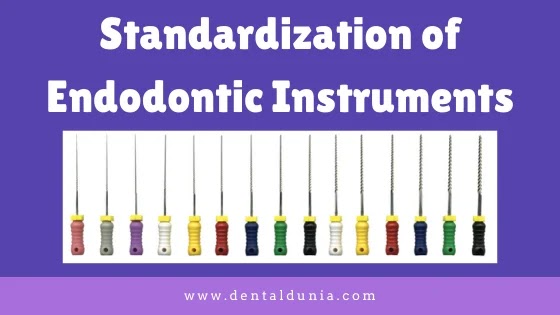Standardization of Endodontic Instruments
{tocify} $title={Table of Contents}
INTRODUCTION
• A variety of instruments are available for the extirpation of the pulp and the instrumentation, preparation, and obturation of the root canal
• Although almost all these instruments were designed between 50 and 100 years ago
• Important changes have occurred in recent years with regard to their quality, efficacy, and standardization.
• Instrumentation of the root canal system requires both hand and rotary files
• No canal system can or should be instrumented with rotary files alone.
HISTORY
STANDARDIZATION OF ENDODONTIC INSTRUMENTS
- Instruments are numbered from 10 to 100. Increase in 5 units up to size 60 and in 10 units till they are size 100. This has been revised to include numbers from 6 to 140.
- Diameter of instrument in 100th of millimeter at the tip is D1
- The working blade shall begin at tip (D1) and extend 16 mm up the shaft (D2).
- D2 should be 0.32 mm greater than D1, ensuring that there is constant increase in taper, i.e 0.02 mm per mm of instrument
- The colors have also been standardized. They are repeated every six instruments, with the exception of the first three of the series(Pink, gray, purple)
- Instruments are numbered from 10 to 100. Increase in 5 units up to size 60 and in 10 units till they are size 100. This has been revised to include numbers from 6 to 140.
- Diameter of instrument in 100th of millimeter at the tip is D1
- The working blade shall begin at tip (D1) and extend 16 mm up the shaft (D2).
- D2 should be 0.32 mm greater than D1, ensuring that there is constant increase in taper, i.e 0.02 mm per mm of instrument
- The colors have also been standardized. They are repeated every six instruments, with the exception of the first three of the series(Pink, gray, purple)
MODIFICATIONS FROM INGLE’S STANDARDIZATION
- An additional diameter measurement point at D3 is 3 mm from the tip of the cutting end of the instrument at D0 (Earlier it was D1) and D2 was designated as D16.
- Tip angle of an instrument should be 75° ± 15°.
- Greater taper instruments (0.04, 0.06, 0.08, 0.10, 0.12) have also been made available.





